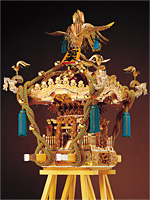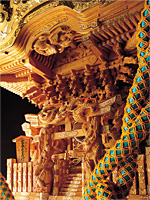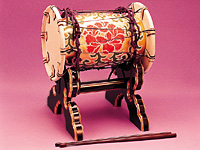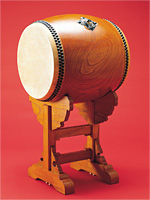【第四十四回目】
宮本卯之助商店:日本の「お祭り」をつくってます!
Miyamoto Unosuke:The creator of the matsuri festivals of Japan
Miyamoto Unosuke:The creator of the matsuri festivals of Japan
| セインさん。今回、ご案内する老舗は「宮本卯之助商店」です。幕末の文久元年(1861)の創業で、お神輿や山車(だし)、太鼓や笛などを作っています。ひとことで言えば「お祭りをつくる」会社です。さあ、入りましょう。 I paid a visit to Miyamoto Unosuke Co., Ltd. in Asakusa. Established in 1861, they make many of the beautiful things used in Japanese festivals―decorative carts, portable shrine, drums, flutes, and much more. Come with me on a tour of the company that makes the Japanese festival possible. |
||
| (宮本) | ようこそ、セインさん。宮本です。 Miyamoto-san:Good morning, Thayne-san. I am Yoshihiko Miyamoto. |
|
| こんにちは、宮本さん。僕もお祭りが大好きですから、今日はとても楽しみにして来ました。地元の根津のお祭りで2回、お神輿もかついでいるんですよ。楽しかった!でも、本当のことを言うと、重くて重くて、とってもつらかったんです(笑)。 I’m a big fan of festivals, so I’ve really been looking forward to this. I helped to carry a shrine two times in Nezu where I live. It was a lot of fun! But to tell you the truth, the shrine was heavy, so it wasn’t easy at all. (Laughing) |
||
| (宮本) | (笑)。お神輿は基礎部分の材木はもちろん、鋳物、金具、飾り紐など2,000ものパーツでできていますから、見た目よりも重いんです。担ぎ手の数にもよりますが、一人、10~20kgはかつぎますから。 Miyamoto-san:There are over 2,000 parts made of wood and also metal castings and fittings and cords, so it’s a lot heavier than it looks. It depends on how many people help to carry it, but each person needs to carry about 10 to 20 kilos. |
|
| お神輿の始まりは? What were the beginnings of the mikoshi? |
 |
|
| (宮本) | 奈良の大仏の開眼供養の時、功績のあった宇佐八幡の神様をお招きしたいという話になって、神様にふさわしい乗り物を、ということで天皇が乗る輿(コシ)を用いることになったのです。それがお神輿のルーツと言われています。 Miyamoto-san:When preparing for the consecration of the Great Buddha statue of Nara (752), people started talking about inviting the powerful god of the Usa-hachimangu Temple. To attract such a god, they needed something worthy of it, and so they prepared a palanquin similar to that used to transport the Emperor. That is said to be the beginning of the mikoshi tradition. |
|
| お神輿には、種類があるんですか? Is there more than one type of mikoshi shrine? |
||
| (宮本) | 大きく、白木のお神輿と、漆を塗ったお神輿の2つに分けられます。白木のお神輿は木目の美しいケヤキの木、漆塗りのお神輿は堅いヒノキを主に使っています。うちのお神輿は構造の主要部分には釘を使わずに、木に凹凸の切り込みを入れて、組み木で作るので、傷んだら、分解して調整したり、一部だけを取り換えたりできるんです。ですから修理をしながら100年、200年と使っていただけるんです。 Miyamoto-san:The portable shrines can be divided into two types: those made with unvarnished wood, and those painted with lacquer. The unvarnished ones are made from a tree with a beautiful grain called the zelkova tree (keyaki). Varnished ones use mainly hard wood from the Japanese cypress (hinoki). We don’t use any nails in the main part of our mikoshi. They are held together by connecting interlocking joints that are carved into the wood, so we can pull the whole thing apart and replace any damaged parts. That makes it possible to use a mikoshi for 100 or even 200 years. |
|
| 日本の木の文化、木を自在に使う技術が、お神輿にも生きているんですね。彫刻もすばらしい。鳥に花、雲に狛犬、いろいろありますね。 Japan has a strong wood culture and craftsmanship tradition, and you can really see that in the mikoshi. The carvings are also beautiful―intricate birds, flowers, clouds, dogs… |
||
| (宮本) | 前後左右に四神<東の青竜(せいりゅう)・南の朱雀(すざく)・西の白虎(びゃっこ)・北の玄武(げんぶ)>、周囲には十二支の動物たちの彫刻もあるんです。十二支は、正面に午(うま)が来るのが決まりなんです。 Miyamoto-san:On each side is one of the four gardian: the Blue Dragon on the East, the Red Phoenix on the South, the White Tiger on the west, and the Black Tortoise on the north. You can also see all the animals of the zodiac carved around each side. The horse always needs to be at the front. |
|
| じっくり見たことがなかったけれど、細かい仕事がいっぱいされているんですね。 I’ve never had an opportunity to look close at a mikoshi, but it looks so intricate. |
 |
|
| (宮本) | 土台となる木地、それから金物、メッキ、彫刻、漆塗り、お神輿の組み上げなど、一つのお神輿は20以上の工程を経て出来上がっているんです。 Miyamoto-san:The base is wood, upon which come gold-plated metal parts, carvings, and coats of lacquer. There are over 20 processes involved in making just one mikoshi. |
|
| 金具も、どれもおもしろい。唐草模様が、いろいろなところに使われていますね。 All these metal fittings are so interesting. It seems like a lot of arabesque patterns are used. |
||
| (永井) | 彫金金具は、お神輿1基に、大小数百点ついています。唐草文様は、奈良の正倉院の宝物にも見られるように、その昔、ペルシャから伝えられたデザインです。シルクロードを通って、日本まで来て、こうして今もいろいろなところに使われているわけです。たとえば、雅楽につかわれる楽器にも…… Miyamoto-san:On each mikoshi, there are several hundred little metal fittings. If you go to Nara, you can see arabesque patterns among the treasures of the Shosoin Repository. The designs came to Japan from Persia centuries ago. They arrived on the Silk Road and were used in various areas of Japanese culture. You can also see these designs in the ancient court-music instruments (gagaku). |
|
| ああ、ほんとだ!雅楽の楽器って、きれいなものですね。色彩が華やか! Yes, I can see that! These gagaku instruments are beautiful. They’re so colorful! |
||
| (宮本) | 外国からご覧になると、日本って墨色というか、モノクロのイメージがあるでしょう?でも、お祭りを見ると、お神輿に太鼓に、提灯(ちょうちん)に法被(はっぴ)……と、それぞれが晴れやかで、ものすごくカラフルなんです。そして、ばらばらなのに、不思議に溶け合っている。これもまた、日本の色なんです。 Miyamoto-san:People outside of the country think Japanese things have an image of being austere black or monochrome. But for festival things―mikoshi, drums, lanterns, and costumes―each item is cheerful, very colorful. But despite all the colors, it seems to somehow come together. This is also one side of the sense of color in Japan. |
|
| 雅楽器は、独特の色づかいが美しいですね。じっと聞いていると、ちょっと眠たくなっちゃって、いい観客じゃないですけど……(笑) 渋いばかりが日本じゃないんですね。そういえば、歌舞伎もカラフルですね。 The unique coloring of the kagaku instruments are beautiful. I’m afraid I get a little sleepy when listening, so I guess I’m not a very good fan.(laughing) So it’s not just simple color tones. I guess kabuki theater is also pretty colorful. |
 |
|
| (宮本) | うちは、歌舞伎ともご縁があるんですよ。歌舞伎は演目によって、いろいろな太鼓や小鼓が使われますし、そのほかに波の音や風の音などの効果音も出てくるでしょう。そういった音に関する一式をレンタルしているんです。 Miyamoto-san:We also have ties with the kabuki world. Each kabuki play uses different types and sizes of drums, and also instruments to make the sounds of waves and wind. We also make those types of instruments and rent them out. |
|
| へー。音のレンタルをされているんですか。 I see, so you rent out sound, then? Oh, for us! |
||
| (宮本) | はい。日本の音楽は、打楽器を中心とした編成なんです。ですから“打楽器王国”と言ってもいいくらい、種類があるんです。ですから、祭礼や盆踊り、舞台など、いろいろなところで必要になる音を、ここに探しにいらっしゃるんです。 太鼓とひとくちに言っても、本当にいろいろな音がするので。 Miyamoto-san:Traditional music is focused mainly around percussion instruments. Japan has so many different percussion instruments it’s sometimes called “drum heaven.” So people come here to look for the various sounds they need for things like festivals, traditional dancing, and stage performances. The word taiko(drum)covers a whole array of instruments. |
|
| なるほど。この太鼓も、すごい貫禄ですね。1本の木をくり抜いて作っているんですか? Interesting. This drum here really has a dignified presence. Is this made by hollowing out a single tree? |
||
 |
長胴太鼓。各地のお祭りや郷土芸能、邦楽のお囃子などのほか、最近はプロ太鼓奏者の公演も多く、さらに音楽のジャンルを超えても使われるようになっている。なお、西浅草店の4階には「太鼓館」と名付けられた世界の太鼓を集めた博物館もあり、太鼓の魅力が紹介されている。 This is a nagado-daiko: used in regional festivals, cultural events, and accompaniment for traditional Japanese music. This drum has recently been used in performances by professional drummers, and in non-traditional music genres. On the fourth floor of the Nishi-asakusa store of Miyamoto Unosuke, you’ll find the Drum Museum where drums from around the world are on display. Pay a visit and you’ll soon fall in love with the drum. |
|
| (宮本) | はい。太鼓も一番いいものは木目の美しさもあってケヤキの木で作るんです。ただ、最近、日本には大きなケヤキの木がなくなってきたので、大太鼓の多くはカメルーンのブビンガという木を使っています。 いずれも、木を切り出した後、何年間も日陰でゆっくり乾燥させたものを仕入れ、うちでもさらに3年から5年寝かせてから、鉋(かんな)で丁寧に削っていきます。そして、音を決めたら、牛皮を張って、鋲(びょう)で留めます。体に響くような重低音も、軽やかな音も、木と対話しながら作っていく職人の技で決まるんです。 Miyamoto-san:That’s right. The zelkova(keyaki)with its beautiful grain is best for making drums. But now it’s hard to find large trees in Japan, so a lot of the drums today are made using bubinga trees from Cameroon. The trees are cut in portions and allowed to dry for several years in the shade, and then after maturing for three to five years, they are carefully hollowed out. Then leather is placed over the top and fastened down with tacks. It takes a craftsman skilled in “conversing” with the tree to create the low and soft sounds of a quality drum. |
|
| すごいですね。それにしても宮本さんのお仕事は、幸せなお仕事ですね。 It seems that you have a good job. |
||
| (宮本) | そうですね。物を買っていただいているのに、お客様から「ありがとう」と言っていただける。そして、1年中「おめでとうございます」という挨拶のなかで仕事をしているのですから、本当に幸せだと思います。 お祭りは、人と人とのふれあいの場をつくるでしょう。肩書きも関係ない、老いも若きも関係なく人々を結びます。そして、地域のつながりをつくっていきます。子どもがいたずらをしていたら、自分の子どもでなくても叱るし、お年寄りには元気ですねと声もかける。お祭りの間に、ご近所の顔が見えてくるんです。知らないうちに治安がよくなってきた、という話もよく聞きます。そのお祭りをささえる仕事をしているのですから、それは幸せです。 Miyamoto-san:To be told thanks for something we’re thankful someone has bought is a good thing. What we do is closely related to celebrations, and so it’s really nice to be surrounded year around by people with something to celebrate. Festivals are where people come together―just plain people without regard for titles or age or anything else. It’s about creating communities. Children growing up in a place where all the adults watch out for them, and the elderly being made to feel important. During festivals, you really see who your neighbors are. I’ve even heard that places with active festivals are actually safer. It’s our job to make such festivals possible, and that’s a pretty good thing. |
|
| ここは、日本を知るのにも、いい場所ですね。 I guess this is a good place to really learn about Japan. |
||
| (宮本) | はい。いま、日本の人たちは西洋化された日常を送っていますが、文化と言うのは民族的な価値観に支えられているものです。この先、どう変わっていくかわかりませんが、大切なものなら、必ず残っていくでしょう。その時に、きちんと“日本”をガイドできる店でありたいと思っています。 Miyamoto-san:I think so. Japanese mostly live in a westernized world, but culture is what holds up the ethnic values of a people. I don’t know what the future will be like, but I’m sure the important things will last. I hope that we can last and continue to be a guide for “Japan” in the future. |
|
| 今日はありがとうございました。 Thank you for your time today. |
||
| (文)太田美代 (英訳)デイビッド・A・セイン | ||
 1959年、米国生まれ。証券会社勤務を経て来日し、翻訳・通訳など多岐にわたって活躍。豊富な教授経験を生かし、数多くの英語関係書籍を執筆。近著に『日本人のチョットへんな英語』(アスコム)、『超入門シャドーイング』(主婦の友社)、日本人が使いすぎる英語(PHP文庫)など多数。
1959年、米国生まれ。証券会社勤務を経て来日し、翻訳・通訳など多岐にわたって活躍。豊富な教授経験を生かし、数多くの英語関係書籍を執筆。近著に『日本人のチョットへんな英語』(アスコム)、『超入門シャドーイング』(主婦の友社)、日本人が使いすぎる英語(PHP文庫)など多数。下町の魅力に魅了され、自身が代表を務める英語関連のコンテンツ会社のエートゥーゼットのオフィスを根津に構えている。英会話本の執筆をしながら、東京・文京区根津と春日にあるエートゥーゼット英語学校の校長も務める。
http://www.smartenglish.co.jp/







